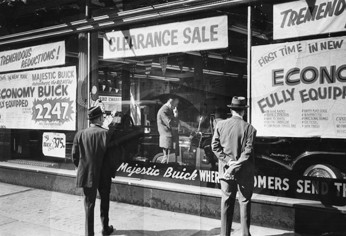Sell what sells!
 Car clearance, 1957. A car dealership tries to clear its stock before the arrival of new cars, 1957.Neal Boenzi/The New York Times Photo Archives
Car clearance, 1957. A car dealership tries to clear its stock before the arrival of new cars, 1957.Neal Boenzi/The New York Times Photo Archives(Doing some planning for opening a business and this story jibes with what I was told. People want Diet Coke. They don't want a "craft-produced cola product" they want Diet Coke...)
From the Give to Get e-Newsletter:
It means that if you hope to attract lots of customers to your business, then you should choose products and services that lots of people already want. Did you see the word 'lots' in that sentence? If you choose a product or service that very few people want, then how can you ever hope to attract 'lots' of people. Lots of people want chocolate ice cream. Very few people want spinach-flavored ice cream.There must already be a large enough demand for your products or services to support your sales goals for your business.!
Does that sound obvious? It really isn't. We see businesses every day trying to sell things that very few people want. One of the biggest mistakes business owners make is in trying to promote their slow moving products--translation: products that few people want -- instead of promoting their winners -- the ones that lots of people want.
When we first met one of our fast-food clients, they were trying to promote their lowest selling product -- roast beef sandwiches -- on their outdoor sign. Of course, it was a waste of time because that's not what people wanted from them. We had him change his strategy to promoting his best selling product -- cheeseburgers, and his sales took a significant leap upward.
Don't try to change the tastes and desires of the world.You will go broke trying to do so.
Here's another example of what we mean. Suppose you owned a gift shop and you prominently displayed and promoted 6 gift items. Now let's say that 3 of those items sold very well, and 3 didn't sell well at all. What would you do? Many business owners might be tempted to put more promotional energy into the 3 items that didn't sell very well so that they could increase their overall sales.
That would be the worst thing you could do. Obviously, your customers were trying to give you a message. The message should have been loud and clear; 'Wedon't want those last three products -- we love the first three products! 'If you said you would 'stop ordering what people don't want, order more of what people do want, then put even more promotional energy into the winners,' then you understand the first rule of giving people what they want.



0 Comments:
Post a Comment
<< Home